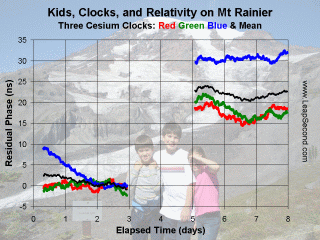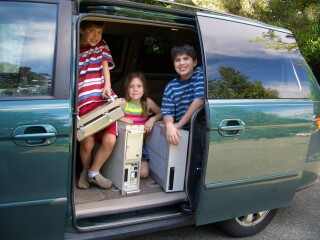LeapSecond.com
Project GREAT:
General Relativity Einstein/Essen
Anniversary Test
Clocks, Kids, and General Relativity on Mt Rainier
Created 24-Sep-2005, updated 22-March-2007
Summary
In September 2005 the kids and I took several very accurate cesium atomic
clocks from home and parked 5400 feet up Mt Rainier (the volcano near Seattle)
for a full two days.
The goal was to see if the clocks actually gained time,
even if billionths of a second,
as predicted by Einstein's general theory of relativity.
Does gravity really alter time and can this weird phenomenon be
detected with a family road trip experiment?
See photos of Project GREAT (the clocks, the kids, the van, the mountain, etc.)
Project GREAT in Physics Today Letters:
WIRED magazine coverage:
Atomic clock humor pages related to Project GREAT:
Below is an informal description of Project GREAT.
References to more technical papers can be found at the end of this page.
Results
If you don't want to read the details about the experiment,
at least look at this one graph.
Superimposed on a photo of the kids at Glacier Vista on Mt Rainier is
a graph showing the timekeeping accuracy of three cesium clocks (red,
green, blue
lines). We, and the clocks, spent three days at home, then two days up on the
mountain, and three more days back at home.
The plot covers 8 days; measurements while at home before and after the trip were made against atomic clocks in my lab and are accurate better than a nanosecond.
We, and the clocks, spent three days at home, then two days up on the
mountain, and three more days back at home.
The plot covers 8 days; measurements while at home before and after the trip were made against atomic clocks in my lab and are accurate better than a nanosecond.
According to Einstein, fast-moving clocks run slow (special relativity), and high-elevation
clocks run fast (general
relativity). Clocks that run fast gain time, so given our high elevation and how long we stayed,
the prediction was that
these clocks would gain about 22 nanoseconds. This, not because the clocks were
moving (they were in a parked minivan),
but simply because the clocks experienced a lower gravitational field by being 5400 feet above sea level for two days.
Of course, the predicted effect is incredibly small,
but with clocks accurate enough,
elevations high enough,
the stay long enough,
and time interval counters precise enough,
the effect becomes measurable.
The goal of this fun experiment was to measure, or at least to demonstrate,
relativistic time dilation using equipment I had at home.
The plot show the clocks aren't perfect
(even these excellent atomic clocks vary randomly at the nanosecond level) but they each
undergo positive time dilation and the
average (black line) time jump in the three clocks while up on the mountain
for two days is around 23 nanoseconds. Not bad for a first attempt.
Theory
// next //
Physics Today
My letter about Project GREAT appeared in the March 2007 issue of Physics
Today.
|
Title:
An Adventure in Relative Time-Keeping
Letter:
I enjoyed Daniel Kleppner's Reference Frame about the relativistic effects
of elevation on precise clocks (PHYSICS TODAY, March 2006, page 10).
He would be amused with an experiment I did with my kids last year.
The year 2005 was the widely publicized 100th anniversary of Einstein's first
paper on relativity and the lesser-known 50th anniversary of Louis Essen's
first cesium clock. To celebrate, I created Project GREAT
(General Relativity Einstein/Essen Anniversary Test),
perhaps the first "kitchen science" relativity experiment.
As a collector of vintage and modern atomic clocks, I discovered it was possible,
using gear found at home, to convert our family minivan into a
mobile high-precision time laboratory,
complete with batteries, power converters, time interval counters, three children,
and three cesium clocks (see photograph).
We drove as high as we could up Mount Rainier, the volcano near Seattle, Washington,
and parked there for two days. The trip was continuously logged with GPS;
the net altitude gain was +1340 meters.
Given the terrestrial blueshift of 1.1 × 10-16
per meter mentioned by Kleppner and integrating our altitude profile,
we predicted the round-trip time dilation to be +22 nanoseconds.
This is remarkably close to what we experimentally observed when,
after we returned, the ensemble of portable cesium clocks was again
compared with atomic clocks left at home (see graph).
Instead of fanciful stories of rocket ships and twins,
the kids got a hands-on introduction to general relativity with
real clocks and a family road trip.
Furthermore, by being at high altitude for the weekend,
we experienced more time together, relatively speaking.
It was the best extra 22 nanoseconds I've ever spent with the kids.
So, yes, not only do we live in a time when atomic clocks are altimeters,
but when relativity is child's play.
|


PTTI Abstract
Project GREČAT was presented at the PTTI conference in December 2006.
Below is the abstract of the talk.
|
Title:
Project GREAT: General Relativity Einstein/Essen Anniversary Test
Abstract:
The year 2005 was the 100th anniversary of Einstein's first paper on relativity.
It was also the 50th anniversary of Essen's first cesium atomic clock.
Project GREAT (General Relativity Einstein/Essen Anniversary Test) was conceived to celebrate both events in a single experiment.
This paper presents the historical background,
implementation details,
and surprisingly successful results of Project GREAT,
a modern demonstration of relativistic time dilation by carrying multiple portable cesium clocks to high altitude and directly measuring the clock effects of gravitational blueshift as predicted by general relativity.
Although several similar,
and now classic,
traveling clock experiments have been performed since the early 1970s this one is unique for a number of reasons.
This is perhaps the first case where the general theory of relativity is confirmed with a family weekend road trip using surplus atomic timing equipment.
The performance of a large collection of vintage and modern cesium standards was measured and the best three clocks pre-selected for the round-trip experiment.
With an assortment of sub-nanosecond time interval counters,
data logging equipment,
AC/DC power distribution systems,
and a large set of batteries the family minivan was converted into a
mobile atomic time lab.
The clocks were driven to the highest point accessible by road on Mt Rainier,
the iconic volcano near Seattle, Washington,
and kept at altitude for 40 hours.
Continuous 3-way inter-clock phase measurements were collected during the trip and 5-way rate measurements were made against hydrogen maser references for days both before and after the trip.
In addition to practical advice for constructing a mobile time lab,
theoretical and actual results,
the paper explores multiple algorithms to extract precise time dilation measurements from the raw data.
|
PTTI technical paper PDF, available Spring 2007
PTTI PowerPoint presentation PDF, available by request.
Time-Nuts
Here's the email about Project GREAT to the Time-Nuts
mailing list.
|
From: "Tom Van Baak" <tvb*leapsecond.com>
To: "Discussion of precise time and frequency measurement" <time-nuts*febo.com>
Sent: Saturday, December 09, 2006 07:15
Subject: [time-nuts] Cesium Clocks and Relativity (Project GREAT)
First a little humor:
http://www.leapsecond.com/pages/atomic-tom/
There is an atomic clock experiment I've wanted to do
for years.
I assume many of you know that, according to Einstein's
special theory of relativity, clocks moving fast run slower.
Similarly, according to his general theory of relativity, even
stationary clocks in a stronger gravitation field run slower.
It follows then that clocks at rest on a mountain run faster
than clocks at rest near sea level. It's a tiny amount, to be
sure: the effect is about 1e-16 / meter; which is why none
of us really notice it with our cesium clocks at home.
Since the 1970's when cesium clocks got stable enough,
and portable enough, this relativistic effect on clocks has
been demonstrated many times. You may have read about
the USNO east/west round-the-world flying clock experiment
by Hafele & Keating, or the airplane altitude experiments
by Alley, or the NASA rocket experiment by Vessot.
You could call these guys professional time-nuts and their
experiments are now classic. Of course, today we have
things like GPS which indirectly demonstrate SR and GR
continuously. And BIPM routinely compensates for altitude
in the national laboratory's primary standards into the UTC
calculation.
Anyway, ever since hearing about clocks and relativity I
wondered if it was possible for an amateur to pull off one
of these flying or traveling clock relativity experiments.
Could one of us actually see the effects of GR on our
atomic clocks? Or is the effect too small? Are the surplus
cesium clocks we get on eBay accurate enough? What
would it take to measure it? To me, seeing, measuring,
and proving relativity was always a kind of holy grail of
an amateur precise time hobby.
So that's what Project GREAT is all about. Please feel
free to offer comments or ask questions. While I finish
writing the paper, you'll find the abstract of the talk and
a few photos here:
http://www.LeapSecond.com/great2005/
The rest of the content will appear shortly.
/tvb
|
Notes & Links
Send comments or questions to: tvb
Return to LeapSecond.com home page.
Project GREAT: General Relativity Einstein/Essen Anniversary Test
 We, and the clocks, spent three days at home, then two days up on the
mountain, and three more days back at home.
The plot covers 8 days; measurements while at home before and after the trip were made against atomic clocks in my lab and are accurate better than a nanosecond.
We, and the clocks, spent three days at home, then two days up on the
mountain, and three more days back at home.
The plot covers 8 days; measurements while at home before and after the trip were made against atomic clocks in my lab and are accurate better than a nanosecond.
